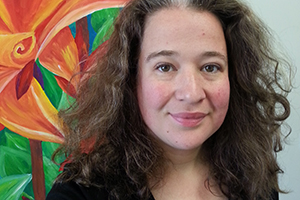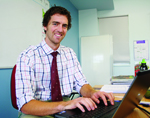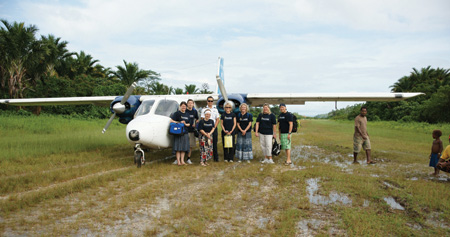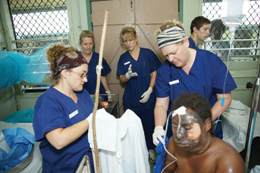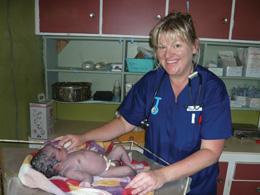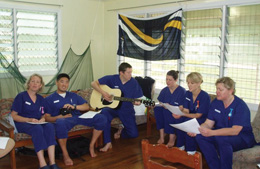In 1942 the South-West Pacific high command co-opted Adventist missionary Pastor Norman Ferris to provide navigational advice and pilotage for the allied fleet in the Solomon Islands campaign of the Second World War.
Norman Ferris had studied at Avondale from 1921 to 1923, after which he was appointed to ministerial work in Sydney. In 1925 he married Ruby Chatman, a 1923 graduate of Avondale’s Business Course. In 1927 he and Ruby were called to pioneering missionary work in the Solomon Islands, where they served for the next fifteen years. They conducted medical missionary work among the islands and coastal villages, teaching the people about the love of Jesus, and in 1933 established a training school for national teachers on the island of Guadalcanal. Travelling from place to place by boat, Norman Ferris gained an intimate knowledge of the coastlines, reefs, channels, currents and anchorages of the treacherous Solomon Island waters.
During the Second World War the Japanese occupied the Solomons with the objective of cutting supply and communication between Australia and the US forces in the Pacific, and establishing a protective flank for the Japanese offensive in New Guinea. As the Japanese pushed southwards through the Pacific islands, Australian civilians were ordered to leave the Solomons in January 1942. Ferris took with him his valuable navigational charts, which showed the safe routes through the dangerous reefs and atolls of the Solomons.1
When Ferris arrived in Australia, customs officers confiscated these charts and delivered them to defence high command, for whom they had special interest. The allied Pacific forces were at that time planning a major counter-offensive to push the Japanese from the Solomons, with a view to establish bases there to support operations against the Japanese occupying islands further to the north. The charts came to the attention of General Douglas MacArthur, supreme commander of allied forces in the south-west Pacific, who was then based in Australia. He noticed on one of the charts a pencilled mark identifying a previously uncharted reef, and inquired who had made that mark. On learning that the charts had been the property of Norman Ferris, he ordered one of his officers who knew Ferris to search him out and bring him to high command.2
Ferris was now living in Adelaide as youth director of the South Australian Conference of the Seventh-day Adventist Church. While shopping one day with his daughter Marilyn in Adelaide, he was accosted by the officer who had been sent to find him. The officer instructed Ferris to pack his bags, say good-bye to his family, make arrangements with his employer, and accompany him to Sydney forthwith.
For the next three weeks in Sydney Ferris briefed the Allied Geographical Section of defence high command with detailed information about navigation in the waters surrounding the Solomon Islands. Senior defence personnel subsequently consulted Ferris in Adelaide.3 He also met with General
MacArthur.4
When the allied forces landed in the Solomons on August 7 and 8, 1942, Macarthur appointed Ferris to pilot the ships in, which he did successfully. Ferris remained with the allied fleet in the Solomons for some weeks. The accompanying photograph, taken in a bunker in the Solomons, and supplied by Ferris’s daughter Marilyn, shows Ferris (third from left) reporting to the commander of the allied forces in the Solomons that he had successfully accomplished his mission. Ferris is wearing General Macarthur’s personal ring, given to him to signify the authority vested in him as pilot of the fleet. Ferris’s navigational charts of Solomon Island waters are now in the University of Tasmania.5
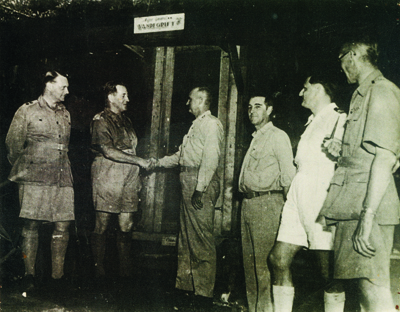
Norman Ferris (third from left) reports to the commander of allied forces in the Solomons that he has successfully piloted the allied invasion fleet through the treacherous waters of the islands. With him are senior officers of the allied forces in the Solomons.
Norman and Ruby Ferris’s fifteen years of mission service in the Solomons transformed the lives of an incalculable number of people, many of whom themselves became missionaries to their own people and to other Pacific nations. The rigours of pioneer mission life might have daunted people less committed and intrepid than Norman and Ruby Ferris. They endured isolation, malaria and, in the early years of their mission service, primitive living conditions in houses that they built of native materials with no protection from flies and mosquitoes. They would try to smoke out the mosquitoes by burning wet chips. At one mission station the only facility for bathing and washing clothes was a lice-infested stream. There were also the hazards of the sea. One night the boat on which they were travelling lurched as it ran aground on an uncharted reef, hurling their baby into the sea. One of the nationals on board saved the baby, but only after diving three times to locate it under water. Ferris was an excellent carpenter and diesel mechanic; he had to be. At the training school that he established on the island of Guadalcanal, he worked with the nationals to construct the school building, church and dormitories. He also built the furniture.6
When entering new areas, the Ferrises were typically able to win the confidence of the people through their medical work; but in a few places they encountered fierce opposition. An enraged warrior rushed to kill Ferris as he landed on the island of Bellona, but was immobilised by divine power. A devil priest on Guadalcanal also tried to kill him, but was similarly restrained. The devil priest later came to accept the love of Christ and became a missionary to his people. Constant trust in God strengthened the Ferrises to persevere despite many hardships.7
The enduring impact of their work may be gauged from the faithfulness during the war years of the nationals who had embraced Christianity as a result of their witness. Kata Ragoso (pronounced Rangoso), who gave inspired leadership in the Solomons during the war years, reported that on the island of New Georgia, the site of the mission headquarters, “not one teacher left his post or let down the standard of the Advent movement during this whole period.”8 Despite suffering great hardships, the national workers constructed and dedicated sixteen new churches and baptised over a hundred persons during the war years.9 Defence personnel highly praised the Adventist nationals who rescued and gave first aid to wounded servicemen during the war.10
Several months before the end of the war in the Pacific, the British Solomon Islands administration granted Norman Ferris and two other missionaries permission to return to the Solomons. In June 1945 Ferris travelled by troop ship to Bougainville, then by American military transport plane to Guadalcanal in the Solomons. He described his joy on arriving aboard an American naval vessel at the mission headquarters at Batuna on the Marovo Lagoon, New Georgia, and meeting again the nationals who had carried on the work of the mission in his absence.11 He reported that the church’s property there was in surprisingly good condition.12 Ferris stayed several months in the Solomons with a brief to re-establish contact with mission stations, ensure that their programs were operating, assess the condition of the local churches, report on the state of property and equipment, evaluate needs, and liaise with the Solomon Islands administration concerning the Adventist mission program.13 During this time he was able to provide much encouragement and pastoral support to church members and national teachers and ministers.
While at Batuna, Ferris restored the mission ship Portal. Shortly after the Adventist missionaries had left the Solomons in 1942, an army officer had tried to burn the Portal to prevent it being used by the Japanese. The ship, however, did not burn. The local Adventist nationals hid it in a creek and distributed the engine parts among the villagers for safe keeping. When Ferris returned, the people retrieved all the parts for re-assembling.
On his return to Australia, Ferris was appointed director of the men’s residence at Avondale College (1945-1951). Then in 1952 the governor of Fiji, Sir Ronald Garvey, requested Ferris to become the administrator on the island of Pitcairn. Many years before, the Ferrises had befriended Ronald Garvey when he was a young colonial officer in the Solomon Islands. Garvey admired Norman Ferris’s tact, kindness and administrative ability in his relations with the national people. Pitcairn was now under Garvey’s administration, and he invited Ferris to be his official representative on the island. During their three-year residence on Pitcairn the Ferrises led the people in spiritual revival, helped resolve animosities between families, and led in the building of a new church.14
In recognition of his service for Christianity, government and the people of the Pacific, Ferris was awarded the honour of Member of the Order of the British Empire (MBE). Sir Ronald Garvey, Governor of Fiji, conferred the honour on behalf of the Queen.15
1 Eileen E. Lantry, Broken Stick. Mission to the Forbidden Islands. Hagerstown, MD: Review and Herald Publishing Association, 2010, pp. 70-71.
2 Information in this and subsequent paragraphs about Ferris’s involvement with the defence forces was provided by his daughter, Marilyn Peatey (an Avondale graduate of 1953).
3 Notes prepared by S.V. Stratford, Secretary, Australasian Union Conference of the Seventh-day Adventist Church, to brief L.V. Wilkinson, President of the Fiji Mission, in seeking assistance from the British High Commissioner in Fiji to obtain approval for Norman Ferris and two other expatriates to return to the Solomons (1943). Adventist Heritage Centre, Cooranbong, Box 757.
4 Interview with Marilyn Peatey, 24 August 2010.
5 Interview with Marilyn Peatey, 24 August 2010.
6 Lantry, Broken Stick, chapters 2-4, 7.
7 Ibid., chapters 1, 5.
8 Kata Ragoso, “War years in the Solomons,” Australasian Record, 6 May 1946, pp. 4-5.
9 Ibid.; Ragoso, “They remained true to God,” Australasian Record, 28 October 1946, pp. 4-5.
10 Norman Ferris, Report to the Australasian Union Conference. Adventist Heritage Centre, Box 757.
11 Letter from Norman Ferris to S.V. Stratford, 11 June 1945. Adventist Heritage Centre, Box 757.
12 Norman Ferris, Report to the Australasian Union Conference. Adventist Heritage Centre, Box 757.
13 Arnold Reye, “They did return! The resumption of the Adventist mission in the Solomon Islands after World War II – Part II,” Journal of Pacific Adventist History, Vol. 7, No. 1, June 2007, pp. 6-7.
14 Norman Ferris, The Story of Pitcairn Island. Washington, DC: Review and Herald Publishing Association, 1957, pp. 117-122.
15 Lantry, Broken Stick, pp. 92-93.
